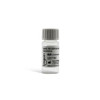Description
IAXO-103 (CD14/TLR4 Antagonist) (synthetic) | IAX-600-003-M001
N-(3,4-Bis-tetradecyloxy-benzyl)-N-cyclopentyl-N,N-dimethylammonium iodide
Small molecule CD14/TLR4 ligand/modulator. Glycolipid. Lipid A analogue.
Persistent inflammation has been implicated in the pathogenesis not only of diverse chronic diseases such as neuropathic pain, atherosclerosis, chronic hepatitis, and abdominal aortic aneurysm, but also acute organ failure, cardiac infarct and stroke.
The Toll-like receptor (TLR) family members are key contributors to these pro- inflammatory conditions. These pattern recognition receptors respond to molecular patterns in components of bacteria and viruses. In addition to their role in detecting pathogen associated molecular patterns (PAMPs), TLRs can also sense endogenous danger (or tissue damage) associated molecular patterns (DAMPs) and have been implicated in perpetuating inflammatory cascades in the absence of invading microbes or other pathogens.
TLR4’s well-known key role in orchestrating innate and adaptive immune response to Gram-negative bacteria now extends into the area of mediating auto-inflammation and tissue repair and re-modelling.
IAXO compounds hold considerable promise in pharmacological settings, where inhibition of sterile (auto-) inflammation is desired, without compromising TLR4’s key role in the defense of pathogens. CD14-dependent and independent TLR4 activation in the central nervous system by endogenous factors has been recently related to a wide array of inflammatory neurological diseases such as amyotrophic lateral sclerosis and Alzheimer’s disease.
Product Specific References
[1] Glycolipids and benzylammonium lipids as novel antisepsis agents: synthesis and biological characterization.
Piazza M, et al. J. Med. Chem. (2009); 52:1209
[2] Evidence of a specific interaction between new synthetic antisepsis agents and CD14. Piazza M, et al. Biochemistry (2009); 48:12337
[3] Therapeutic targeting of innate immunity with Toll-like receptor 4 (TLR4) antagonists. Peri F, Piazza M. Biotechnol. Adv. (2012); 30:251 REVIEW
[4] Exploring the LPS/TLR4 signal pathway with small molecules. Peri F, et al.; Biochem Soc Trans. (2010); 38:1390 REVIEW
[5] Multivalent glycoconjugates as anti-pathogenic agents. Bernardi A, et al.; Chem Soc Rev. (2013); 42:4709 REVIEW
[6] Toll-like receptor 4 (TLR4) modulation by synthetic and natural compounds: an update. Peri F, Calabrese V. Med Chem. (2014); 57:3612 REVIEW


-925-p__84999.1660057617.jpg?c=1)
-925-p__00305.1660057617.jpg?c=1)

-925-p__84999.1660057617.jpg?c=1)
-925-p__00305.1660057617.jpg?c=1)






